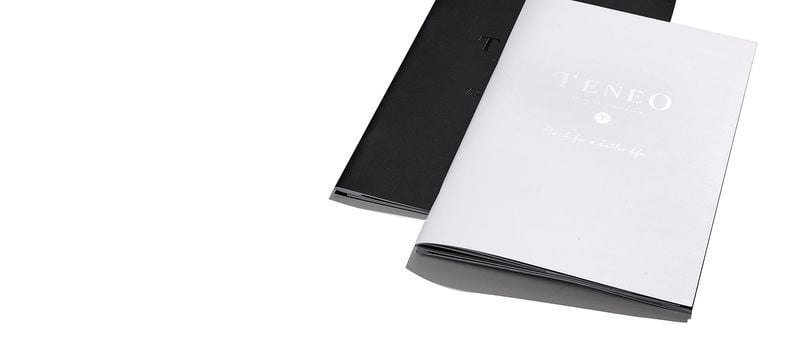Foils Ain't Foils Consider the creative, cost effective and quick options available
Back then there were a vast number of choices: gold and silver These days, things have changed significantly. Not just content with the run of the mill foils, we are now offered a plethora of choices. Metallic gloss and matt, pigment colours, holographic, security foils the list goes on
I have written previously about innovation and my obsession with using foils. With great determination my research led me to the US where I sourced technology that allowed me to digitally print with foil. It's not that easy to do, yet with persistence, experimentation and some good luck you can get some amazing results.
Digital foiling is not a new process, but rather a significant refinement from the Omnicron technique (for those of you old enough to remember!). We call it 'digital foiling' because the printed sheets come off our digital printing press in preparation for foiling on another device. This new enhanced technology can significantly change the dynamics of how we can now produce things for the design community.
For instance, these new techniques allow for foiling the finest of details and halftones, we can print over foiled patterns, print individual foiled variable data names and images.
We have even successfully digitally foiled onto Brillianta linen. This was showcased in the recently completed Footpath Philosophers, arguably Australia's largest book produced digitally. The cover had a halftone image with white foil, and all digitally printed!
This technique had never been produced before and allowed for detailed halftones to be foiled on to fabric and then case bound. With a little imagination and creative flair, coupled with innovative and ground-breaking techniques, the scope is limitless.So, if you, like me are aiming for a return on your investment, come aboard the innovation train and think foils!
Theo Pettaras is a self-confessed design junkie and veteran in the printing industry. He was one of the first commercial printers to become an exclusive digital print producer. Since commencing his Sydney company, Digitalpress, in 2006, his company has achieved multiple state and national print awards including 2008's most innovative printing company for a staff of 10 or under in New South Wales.Some good advice to get you out of a bind We hope this helps
It's the last procedure in the the print process, binding is an integral part of the production mix. It is therefore essential for printing companies to find better ways to offer customers unique binding solutions that add value to their requirements. Providing new and unique binding methods that incorporate combining new and traditional book binding methods can created a pleasant outcomes. We hope you find this information helpful.
binding styles
Binding is the term used for the range of processes involved that hold printed pages together. Different binding methods allow designers to make choices on the look, functionality and costs associated with a book. Binding choices also have a direct influence on the durability of a book. Listed here are some of the most common types of binding methods used today.
Wiro binding
This is the method whereby wire coils hold pre-punched covers and pages together. The main benefit of this method is the ability to allow pages to lie completely flat. You must ensure images and text do not run through the pre-punched pages. Other ways to bind using this method include Full and Half Canadian, which have wraparound covers a Full Canadian has a covered spine whilst a Half Canadian has an exposed spine.
Case binding
Books are made from all types of cover materials including fabrics, buckram, paper or pre-printed sheets. These sheets are glued and wrapped around thick box-board, and text pages are then bound into the covers. New methods are now available allowing for personalised custom covers that can be produced very efficiently.
Perfect binding
This is a very a popular binding method, which requires printed sheets to be formed into a block and glued at the edges with a flexible adhesive. The quality of the adhesive will determine how durable the book will be. PUR glue is often the preferred option.
Singer sewing
This is a machine-sewn binding method available in a range of thread colours and stitch lengths. It's great for any size books with smaller print quantities.
There are, of course, many other methods, which depend on the type of finish you desire, as well as other factors such as costs, timeline and if you can find someone to provide the desired binding service. Some of these include: Z -binding, interscrew binding, bellyband, Japanese binding, self-binds and the list goes on.
The binding solution
Understanding these binding methods and obtaining a greater appreciation for them is important. The method chosen could greatly impact the look and intended outcome of a project. Some of these methods have been passed on through generations for centuries. With the reliance on computers and all the technology we have at hand, we run the risk of losing these traditional ways to bind. Surely this is a missed opportunity for both the designer and their clients.
My advice is to read as much information as you can about the wonderful binding methods that exist. While I understand the commercial viability of producing some of these types of binding methods may be unrealistic, do not be afraid to ask your printer and have them do some research for you. We learn from our customers every day and would welcome the opportunity to explore these possibilities.
It is this type of synergy between designers and printers that pushes boundaries and allows fresh ideas to come to fruition. Whether you require something new, something complex or a traditional method that warrants a revisit, the binding finish you choose is a very important final touch.
Need more help?
Download PaperSpecs-BindingCheatSheet this book binding cheat sheet courtesy of our friends at PaperSpecs for more information.
Our new white ink print super white, super fast super cost effective!
digitalpress are super excited about our new white ink printer. we offer the best single pass white ink printing.
Breakthrough Innovation
Digitally print white ink many stocks, in one pass with superb results.
Make your next creative project cut through with whiteinkprint.
Increased Luminosity
Make full colour images stand out on darker backgrounds using dark stock to print full colour images over our whiteinkprint.
Unrivalled Affordability
Digitalpress whiteinkprint is quick, cost-effective and delivers superb results. No need for multiple passes, no expensive setups.
Complete Flexibility
Ideal for a huge range of multi-coloured and dark stocks, kraft board, translucent, clear and cling films. Perfect for variable-data direct mail and envelopes.
To learn more about Digitalpress NEW whiteinkprint contact us today.
Our team will assist you in applying the best whiteinkprint solution.
On The Shoulders Of Giants a tribute to thirteen designers
The importance of this project is supported by history. There is no doubt whatsoever that the Australian graphic design industry came of age during these designers' careful watch. Securing a vibrant and dynamic record of this major part of the our industry's history is a responsibility we should all be part of. As an investment in our future and as a significant part of our heritage. Simon was able to secure all thirteen designers same place same time for this exclusive interview. These included Cato, Cozzolini, Emery, Flett, Kidd, Kin-Yee, Lancashire, Nowland, Sadgrove, Spatchurst, Tucker, Turner and Williamson.
Through hard work, dedication, patience and at a significant financial cost, a beautifully case-bound section sewn book with DVD video footage has been produced. Digitalpress together with some other generous supporters are proud to have been able to support this magnificent project by financially contributing part of the funding. 100 copies were produced with only 5 copies available for sale for $50 plus GST at Beautiful Pages Sydney
)
